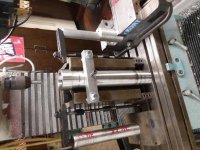Hey there guys, I have been a long time reader but never posted as I typically find the information I need just by searching! Now however I have a part that I'm struggling with for a long time customer of ours.
Basically I'm trying to figure out how to do that deep "face groove" that runs axially down the part. The problem seems to be that its narrow and very deep. Dimensions are: Minor Dia: 0.305" Major Dia: 0.455" Depth from end of part: 1.821". I have been thinking about trying to make a custom annular style cutter as I only need to make one for now but if they go into production that may not be the best way. Any one have any ideas other than trying to find a 2" long 0.0625" EM and praying it doesn't break? Really it would be nice to use something like ThinBit's face groove insert cutter for production but I can't get anywhere near the depth with anything like that I have been able to find.
Thanks in advance!

Basically I'm trying to figure out how to do that deep "face groove" that runs axially down the part. The problem seems to be that its narrow and very deep. Dimensions are: Minor Dia: 0.305" Major Dia: 0.455" Depth from end of part: 1.821". I have been thinking about trying to make a custom annular style cutter as I only need to make one for now but if they go into production that may not be the best way. Any one have any ideas other than trying to find a 2" long 0.0625" EM and praying it doesn't break? Really it would be nice to use something like ThinBit's face groove insert cutter for production but I can't get anywhere near the depth with anything like that I have been able to find.
Thanks in advance!


 .
.